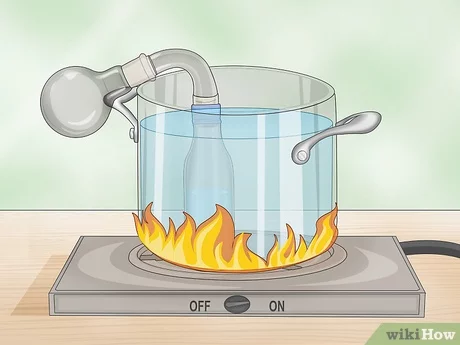The Purity Within: A Guide to Distilled Water at Home

In a world where water quality is of paramount importance, the quest for purity has led many to seek distilled water as a reliable option. Distilled water is free from impurities and contaminants, making it a popular choice for various applications, including consumption. While purchasing distilled water is readily available, having the ability to distill water at home provides not only convenience but also control over the quality of the water you consume. In this comprehensive guide, we’ll explore the methods and benefits of distilling water in the comfort of your own home.
Understanding Distilled Water
Distilled water is created through the process of distillation, a natural purification method that separates impurities from water by boiling it and then condensing the steam back into liquid form. This process effectively removes minerals, contaminants, and other dissolved solids, leaving behind water in its purest form.
Advantages of Distilled Water
- Purity: Distilled water is one of the purest forms of water available. By eliminating impurities through distillation, you can ensure that the water you consume is free from minerals, chemicals, and pollutants.
- Versatility: Distilled water is not only suitable for drinking but is also widely used in various household applications. It is preferred for use in steam irons, humidifiers, and laboratory experiments due to its lack of impurities.
- Health Benefits: Some argue that consuming distilled water may offer health benefits. While the scientific community has varying opinions on this, proponents believe that the absence of minerals in distilled water allows the body to absorb nutrients more efficiently.
Methods of Distilling Water at Home
- Distillation Apparatus: Investing in a distillation apparatus is the most straightforward way to distill water at home. These devices typically consist of a boiling chamber, a condensation coil, and a collection container. The process involves heating water to its boiling point, collecting the steam, and then condensing it back into liquid form. Distillation apparatuses are available in various sizes and designs, catering to different needs.
- DIY Distillation: For those who prefer a hands-on approach, it is possible to create a makeshift distillation apparatus using common household items. A simple setup involves boiling water in a pot, capturing the steam with a lid or foil, and then directing it through a tube into a separate container for condensation. While this method may not be as efficient as a purpose-built apparatus, it can still yield distilled water with patience and attention to detail.
- Solar Distillation: Harnessing the power of the sun, solar distillation is an eco-friendly method to produce distilled water. This process involves placing a container of impure water in direct sunlight, allowing it to evaporate and then condense on a clear surface, such as a plastic sheet. The condensed water is then collected for consumption. Solar distillation is not only energy-efficient but also a sustainable option for those seeking an environmentally friendly approach.
Tips for Distilling Water at Home
- Start with Clean Equipment: Ensure that the distillation apparatus or DIY setup is clean and free from any contaminants before starting the process. This helps maintain the purity of the distilled water.
- Use High-Quality Water: Begin with water that is already free from large particles and sediments. Distillation works more efficiently when the starting water is relatively clean.
- Monitor the Process: Whether using a purpose-built apparatus or a DIY setup, closely monitor the distillation process. Adjust heat levels to maintain a steady rate of steam production and ensure that the condensation process is effective.
- Regular Cleaning and Maintenance: If using a distillation apparatus, follow the manufacturer’s guidelines for cleaning and maintenance. Regularly cleaning the equipment prevents the buildup of residues that may affect the quality of the distilled water.
- Collect in Glass Containers: When collecting distilled water, use glass containers to maintain its purity. Avoid plastic containers, as they may leach chemicals into the water, compromising its quality.
Conclusion
Having the ability to distill water at home is a valuable skill that offers both convenience and control over the water you consume. Whether you choose a purpose-built distillation apparatus, a DIY setup, or harness the power of the sun with solar distillation, the result is the same – pure and distilled water free from impurities. By understanding the methods and benefits of distillation, you can take a step towards ensuring the purity of the water that nourishes your body and enhances various aspects of your daily life.
What is distilled water, and why would I want to make it at home?
-
- Distilled water is water that has undergone the process of distillation, which involves boiling water to create steam and then condensing that steam back into liquid form. Making distilled water at home ensures a pure and contaminant-free water supply for various uses, including drinking and household applications.
Is it safe to drink distilled water?
- Yes, distilled water is safe to drink. It lacks impurities, minerals, and contaminants commonly found in tap or well water. Some people prefer distilled water for its purity, but it’s essential to note that it may not have the same taste as mineral-rich water.
Can I use any water source for distillation?
- While you can use various water sources, starting with relatively clean water is ideal. Distillation works more efficiently when the initial water is free from large particles and sediments. If your tap water has a high mineral content, it might leave mineral deposits in your distillation apparatus over time.
What equipment do I need to distill water at home?
- You can use purpose-built distillation apparatuses available in the market, or you can create a DIY setup using common household items. A basic distillation apparatus includes a boiling chamber, a condensation coil, and a collection container. DIY setups might involve a pot, a lid or foil, a tube, and a separate container for condensation.
Can I distill water without a distillation apparatus?
- Yes, you can distill water at home without a specialized apparatus. A DIY setup involving a pot, a lid or foil, and a tube can be used to capture steam and direct it into a separate container for condensation. However, purpose-built distillation apparatuses are generally more efficient and reliable.
How do I maintain and clean a distillation apparatus?
- Regular cleaning is essential to maintain the efficiency of a distillation apparatus. Follow the manufacturer’s guidelines for cleaning and maintenance, and ensure that there is no residue buildup. Cleaning may involve using vinegar or citric acid to remove mineral deposits.
Is solar distillation effective?
- Solar distillation is an effective and eco-friendly method to produce distilled water. It involves placing a container of impure water in direct sunlight, allowing it to evaporate and then condense on a clear surface. While it may take longer than other methods, it is energy-efficient and sustainable.
Can I use plastic containers to collect distilled water?
- It is recommended to use glass containers to collect distilled water. Plastic containers may leach chemicals into the water, compromising its purity. Glass containers do not impart any additional substances to the distilled water.
Are there health benefits to drinking distilled water?
- The health benefits of drinking distilled water are a topic of debate. While some claim that it allows for better nutrient absorption due to the absence of minerals, scientific opinions on this matter vary. It’s essential to maintain a balanced and varied diet for overall health.
Can I use distilled water for household appliances like steam irons and humidifiers?
- Yes, distilled water is ideal for use in household appliances like steam irons and humidifiers. Its lack of minerals prevents the buildup of scale and deposits, prolonging the life and efficiency of these devices.
- The health benefits of drinking distilled water are a topic of debate. While some claim that it allows for better nutrient absorption due to the absence of minerals, scientific opinions on this matter vary. It’s essential to maintain a balanced and varied diet for overall health.
- It is recommended to use glass containers to collect distilled water. Plastic containers may leach chemicals into the water, compromising its purity. Glass containers do not impart any additional substances to the distilled water.
- Solar distillation is an effective and eco-friendly method to produce distilled water. It involves placing a container of impure water in direct sunlight, allowing it to evaporate and then condense on a clear surface. While it may take longer than other methods, it is energy-efficient and sustainable.
- Regular cleaning is essential to maintain the efficiency of a distillation apparatus. Follow the manufacturer’s guidelines for cleaning and maintenance, and ensure that there is no residue buildup. Cleaning may involve using vinegar or citric acid to remove mineral deposits.
- Yes, you can distill water at home without a specialized apparatus. A DIY setup involving a pot, a lid or foil, and a tube can be used to capture steam and direct it into a separate container for condensation. However, purpose-built distillation apparatuses are generally more efficient and reliable.
- You can use purpose-built distillation apparatuses available in the market, or you can create a DIY setup using common household items. A basic distillation apparatus includes a boiling chamber, a condensation coil, and a collection container. DIY setups might involve a pot, a lid or foil, a tube, and a separate container for condensation.
- While you can use various water sources, starting with relatively clean water is ideal. Distillation works more efficiently when the initial water is free from large particles and sediments. If your tap water has a high mineral content, it might leave mineral deposits in your distillation apparatus over time.
- Yes, distilled water is safe to drink. It lacks impurities, minerals, and contaminants commonly found in tap or well water. Some people prefer distilled water for its purity, but it’s essential to note that it may not have the same taste as mineral-rich water.
- Distilled water is water that has undergone the process of distillation, which involves boiling water to create steam and then condensing that steam back into liquid form. Making distilled water at home ensures a pure and contaminant-free water supply for various uses, including drinking and household applications.
Remember, if you have specific health concerns or are on a restricted diet, it’s advisable to consult with a healthcare professional before making significant changes to your water consumption habits.






